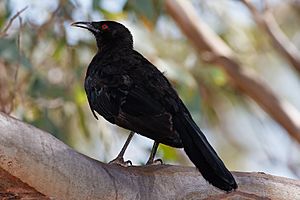Australian mudnester facts for kids
Quick facts for kids Australian mudnesters |
|
|---|---|
 |
|
| White-winged chough (Corcorax melanorhamphos) | |
| Scientific classification |
|
| Kingdom: | Animalia |
| Phylum: | Chordata |
| Class: | Aves |
| Order: | Passeriformes |
| Superfamily: | Corvoidea |
| Family: | Corcoracidae Mathews 1927 |
| Species | |
| Synonyms | |
|
Struthideidae Mathews 1924 |
|
Australian mudnesters are a special group of passerine birds, which means they are perching birds. They get their name because they build their nests out of mud! There are only two types, or species, of Australian mudnesters: the white-winged chough and the apostlebird. Both of these birds live only in Australia.
Contents
Where Do Mudnesters Live?
Both types of Australian mudnesters live in open areas in eastern Australia. They prefer open eucalypt forests and woodlands where the tree canopy isn't too thick.
The apostlebird can also live in drier places, like arid woodlands and shrublands. Both species are quite good at living near people. You can find them in farmlands, suburban areas, and even in parks and gardens.
What Do Mudnesters Look Like?
Mudnesters are medium-sized perching birds. The apostlebird is smaller, about 31 centimetres (12 in) long. The white-winged chough is larger, averaging 47 centimetres (19 in).
They have long, feathered legs and short, rounded wings, which are good for birds that spend a lot of time on the ground.
Feathers and Beaks
The two species look different in their feathers. The apostlebird has duller feathers. The white-winged chough has shinier feathers with a patch of white on its inner wings.
Their bills are also different. The apostlebird has a short, deep bill, a bit like a finch. It uses its bill to pick up food, similar to a sparrow. The white-winged chough has a long, curved bill, like the choughs found in other parts of the world. It uses its bill to flick away leaves and search for food on the ground.
How Do Mudnesters Behave?

Australian mudnesters are very social birds. They spend a lot of time looking for food in leaf litter, walking with a unique style. They call to each other almost all the time. If a human comes near, they fly heavily to a nearby tree. There, they wait for the person to leave, often sitting close together and preening each other's feathers. In parks, they can become very used to people and quite tame.
Social Groups and Family Life
Mudnester groups are led by a dominant male and female. A group can have anywhere from two to twenty birds. A typical white-winged chough group has about six birds, while apostlebird groups usually have seven to nine.
These birds do not migrate. They stay in the same area and protect their territory during the breeding season. This territory is usually about 20 hectares (about 50 acres). After the young birds can fly, the group might roam over a larger area.
If one of the dominant breeding birds dies, the group might break up. The remaining dominant bird will then take young birds from their group and find a single bird to start a new group. Most new birds joining a group are young ones from past breeding seasons. These young "helpers" are very important for successful breeding. In fact, white-winged choughs have even been seen "kidnapping" young birds from other groups to make their own group bigger!
Building Mud Nests
As their name suggests, these birds build their nests out of mud. These nests are shaped like bowls and can take several days to build. It takes even longer if there isn't enough mud because of dry weather. They build nests when rain creates muddy puddles. If possible, they might reuse old nests.
Female birds lay about three to five oval eggs in each nest. All members of the group help to keep the eggs warm for about twenty days. They also share the jobs of feeding and looking after the young birds. Young mudnesters need a lot of care after they hatch. They can take up to 200 days to become fully independent from their parents and helpers.
Species
- White-winged chough, Corcorax melanorhamphos
- Apostlebird, Struthidea cinerea
See also
 In Spanish: Corcorácidos para niños
In Spanish: Corcorácidos para niños

